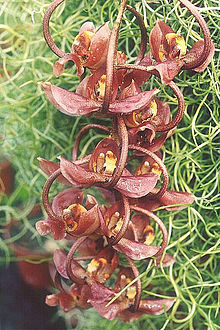Góngora
| Gongora | |
|---|---|
 |
|
| Gongora armeniaca | |
| Scientific classification | |
| Kingdom: | Plantae |
| (unranked): | Angiosperms |
| (unranked): | Monocots |
| Order: | Asparagales |
| Family: | Orchidaceae |
| Subfamily: | Epidendroideae |
| Tribe: | Maxillarieae |
| Subtribe: | Stanhopeinae |
| Genus: |
Gongora Ruiz & Pav. (1794) |
| Species | |
|
See text. |
|
| Synonyms | |
|
Acropera Lindl. |
|
See text.
Acropera Lindl.
Gongora, abbreviated Gga in horticultural trade, is a member of the Orchid family (Orchidaceae). It consists of 65 species known from Central America, Trinidad, and tropical South America, with most species found in Colombia. They grow in wide geographical range from wet forests at sea level to mountainous regions in the Andes, as high as 1,800 m.
The name comes from Antonio Caballero y Gongora, a viceroy of New Granada (Colombia and Ecuador) and the governor of Peru during the Ruiz and Pavón botanical expedition.
Gongora was one of the first orchids described by a western man. Several new Gongora orchids have been discovered in the last ten years, while many others have been assigned under another specific name. Yet there is still some confusion. Many species lack the right description. Some species, such as Gongora portentosa and Gongora superflua, are very rare. DNA fingerprinting will in time contribute to an exact taxonomy of this genus.
All species in this genus are epiphytes with a sympodial growth. The white aerial roots are very thin, growing in a dense pack. Some roots even grow upright instead of hanging down. This specialisation helps in forming the ball of aerial roots. Many are found in association with ant nests.
The conical pseudobulbs are ridged and are about 8 cm long. In some species, such as Gongora similis, the pseudobulb can produce up to six inflorescences in succession. Two alternate leaves originate from the end of each pseudobulb. The leaves are rather leathery and heavily veined, growing to a length of about 30 cm.
...
Wikipedia
